 W
WThe white-tailed antelope squirrel is a diurnal species of ground squirrel, scientifically classified in the order Rodentia and family Sciuridae, found in arid regions of the southwestern United States and the Baja California Peninsula of northwestern Mexico.
 W
WThe pallid bat is a species of bat that ranges from western Canada to central Mexico. It is the sole species of its genus and is closely related to Van Gelder's bat, which is sometimes included in Antrozous. Although it has in the past been placed in its own subfamily (Antrozoinae) or even family (Antrozoidae), it is now considered part of the subfamily Vespertilioninae and the tribe Antrozoini.
 W
WThe spotted bat is a species of vesper bat and the only species of the genus Euderma.
 W
WThe California carpenter bee, Xylocopa californica, is a species of carpenter bee in the order Hymenoptera. It is native to western North America.
 W
WThe canyon bat, also known as the western pipistrelle, is a species of vesper bat. It is found in Mexico and in the western United States. The species has historically been placed in the genus Pipistrellus, but molecular evidence does not show any close relationship with that genus, and accordingly it was classified into its own genus, Parastrellus, in 2006.
 W
WThe desert sucker or Gila Mountain sucker, is a freshwater species of ray-finned fish in the sucker family, endemic to the Great Basin and the Colorado River Basin in the United States. It inhabits rapids and fast-flowing streams with gravelly bottoms. It is a bi-colored fish with the upper parts olive brown to dark green, and the underparts silvery-tan or yellowish. The head is cylindrical, tapering to a thick-lipped mouth on the underside. This fish can grow to 31 in (79 cm) in Arizona but is generally only about half this size elsewhere. There are three subspecies, found in different river basins, and some authorities allot this species its own genus Pantosteus.
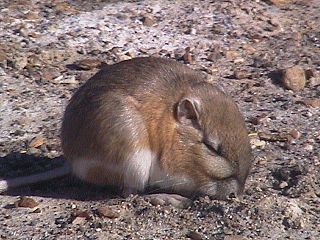 W
WThe chisel-toothed kangaroo rat is a species of rodent in the family Heteromyidae.
 W
WThe northern leatherside chub is a cyprinid fish of western North America.
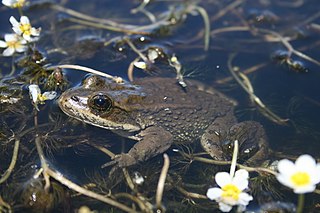 W
WThe Columbia spotted frog is a North American species of frog. It is green to brown in color with spots on the dorsal surface. The belly and upper lip are white in color. Individuals can be distinguished from other Rana species by their shorter back legs, narrow snout, and upturned eyes. Since they spend most of their time in the water, they also have more webbing in their hind feet than similar species. Although not threatened, this animal has been studied as a model species for the effects of habitat fragmentation.
 W
WThe desert cottontail, also known as Audubon's cottontail, is a New World cottontail rabbit, and a member of the family Leporidae. Unlike the European rabbit, they do not form social burrow systems, but compared with some other leporids, they are extremely tolerant of other individuals in their vicinity.
 W
WCrotalus stephensi is a venomous pitviper species found in central and southern Nevada and adjacent California. Common names include panamint rattlesnake, panamint rattler, Owens Valley rattler, and tiger rattlesnake.
 W
WThe Bonneville cutthroat trout is a subspecies of cutthroat trout native to tributaries of the Great Salt Lake, U.S.A. Most of the fish's current and historic range is in Utah, but they are also found in Idaho, Wyoming, and Nevada. This is one of 14 or so recognized subspecies of cutthroat trout native to the western United States.
 W
WLahontan cutthroat trout is the largest subspecies of cutthroat trout, and the state fish of Nevada. It is one of three subspecies of cutthroat trout that are listed as federally threatened.
 W
WPaiute cutthroat trout is one of fourteen subspecies of cutthroat trout. Paiute Cutthroat are native only to Silver King Creek, a headwater tributary of the Carson River in the Sierra Nevada, in California. This subspecies is named after the indigenous Northern Paiute peoples.
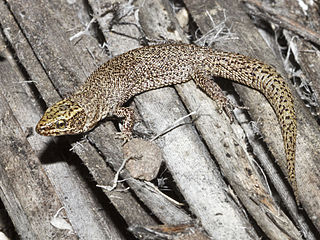 W
WThe desert night lizard is a night lizard native to southern California east of the Sierras and San Gabriel Mountains into Baja California, southern Nevada, southwestern Utah and extreme western Arizona.
 W
WThe golden-mantled ground squirrel is a ground squirrel native to western North America. It is distributed in British Columbia and Alberta through the western United States to California, Arizona, and New Mexico.
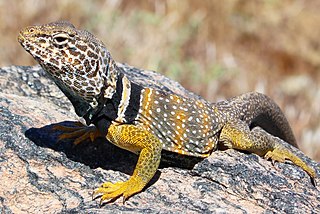 W
WThe Great Basin collared lizard, also known commonly as the desert collared lizard or the Mojave black-collared lizard, is a species of lizard in the family Crotaphytidae. The species is endemic to the Western United States. It is very similar to the common collared lizard, Crotaphytus collaris, in shape and size, but it lacks the bright extravagant colors. Males can be brown to orange and some red or pink on the belly. Females are more black or dark brown. C. bicintores has elongated scales near the claws and the tail is more triangular in shape than round as with C. collaris.
 W
WThe Great Basin pocket mouse is a species of rodent in the family Heteromyidae. It is found in British Columbia in Canada and the western United States.
 W
WThe Great Basin rattlesnake is a venomous pit viper species found in the Great Basin region of the United States.
 W
WThe Great Basin spadefoot is a species of toad in the family Scaphiopodidae. It is 3.8 to 6.3 cm long and is usually colored gray, olive or brown. Great Basin spadefoot toads have adapted to life in dry habitats. They use the hard, keratinized spade on each foot to dig a burrow, where they spend long periods during cold and dry weather. They are opportunistic hunters and will eat anything they can subdue. While their tadpoles have numerous predators, adults are able to produce skin secretions that deter enemies.
 W
WTownsend's ground squirrel is a species of rodent in the family Sciuridae. It is found in high desert shrublands in several areas of the United States.
 W
WHesperopsis libya, the Mojave sootywing, Mohave sootywing, Great Basin sootywing or Lena sooty wing, is a butterfly of the family Hesperiidae. It is found in North America from eastern Oregon east to Montana and south to southern California, Arizona, and north-western Mexico including Baja California.
 W
WThe Inyo shrew is a species of mammal in the family Soricidae.
 W
WThe white-tailed jackrabbit, also known as the prairie hare and the white jack, is a species of hare found in western North America. Like all hares and rabbits, it is a member of the family Leporidae of order Lagomorpha. It is a solitary individual except where several males court a female in the breeding season. Litters of four to five young are born in a form, a shallow depression in the ground, hidden among vegetation. This jackrabbit has two described subspecies: L. townsendii townsendii occurring west of the Rocky Mountains and L. townsendii campanius occurring east of the Rocky Mountains.
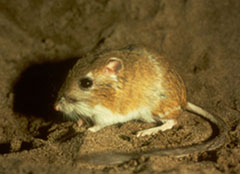 W
WOrd's kangaroo rat is a kangaroo rat native to western North America, specifically the Great Plains and the Great Basin, with its range extending from extreme southern Canada to central Mexico.
 W
WThe Lahontan redside is a cyprinid fish of the Great Basin in eastern California and western Nevada.
 W
WLitaneutria minor, or the agile ground mantis, is native to the drier regions of North America. L. minor is found in the United States in Colorado, Arizona to Mexico, and the eastern regions of Washington to California. They also can be found in Canada in the southern Okanagan Valley and are Canada's only native mantis. They are very active hunters and will be seen running across the ground from early spring to late summer.
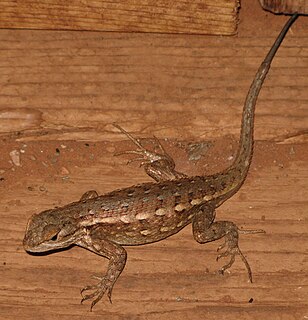 W
WThe sagebrush lizard is a common species of phrynosomatid lizard found at mid to high altitudes in the western United States of America. It belongs to the genus Sceloporus in the Phrynosomatidae family of reptiles. Named after the sagebrush plants near which it is commonly found, the sagebrush lizard has keeled and spiny scales running along its dorsal surface.
 W
WThe zebra-tailed lizard is a species of phrynosomatid lizard endemic to the Southwestern United States and northwestern Mexico.
 W
WLoxosceles deserta, commonly known as the desert recluse, is a brown spider of the family Sicariidae.
 W
WThe mountain cottontail or Nuttall's cottontail is a species of mammal in the family Leporidae. It is found in Canada and the United States.
 W
WThe mustang is a free-roaming horse of the Western United States, descended from horses brought to the Americas by the Spanish. Mustangs are often referred to as wild horses, but because they are descended from once-domesticated animals, they are actually feral horses. The original mustangs were Colonial Spanish horses, but many other breeds and types of horses contributed to the modern mustang, now resulting in varying phenotypes. Some free-roaming horses are relatively unchanged from the original Spanish stock, most strongly represented in the most isolated populations.
Nedra stewarti is a moth in the family Noctuidae. It is found in California and Oregon.
 W
WThe Great Basin gopher snake, also known as the bull snake, is a subspecies of nonvenomous colubrid endemic to the western part of the United States and adjacent southwestern Canada.
 W
WThe Piute ground squirrel is a species of rodent in the family Sciuridae.
 W
WThe pygmy rabbit is a rabbit species native to the United States. It is also the only native rabbit species in North America to dig its own burrow. The pygmy rabbit differs significantly from species within either the Lepus (hare) or Sylvilagus (cottontail) genera and is generally considered to be within the monotypic genus Brachylagus. One isolated population, the Columbia Basin pygmy rabbit, is listed as an endangered species by the U.S. Federal government, though the International Union for Conservation of Nature lists the species as lower risk.
 W
WThe ringtail is a mammal of the raccoon family native to arid regions of North America. It is widely distributed and well adapted to disturbed areas. It has been legally trapped for its fur. It is listed as Least Concern on the IUCN Red List. It is also known as the ringtail cat, ring-tailed cat, miner's cat or bassarisk, and is sometimes called a cacomistle, though this term seems to be more often used to refer to Bassariscus sumichrasti.
 W
WThe greater sage-grouse, also known as the sagehen, is the largest grouse in North America. Its range is sagebrush country in the western United States and southern Alberta and Saskatchewan, Canada. It was known as simply the sage grouse until the Gunnison sage-grouse was recognized as a separate species in 2000. The Mono Basin population of sage grouse may also be distinct.
 W
WSceloporus occidentalis longipes is a subspecies of the western fence lizard, commonly called the Great Basin fence lizard. Several subspecies of the western fence lizard, a species of phrynosomatid lizard, are found in the far western part of North America.
 W
WThe Inyo shrew is a species of mammal in the family Soricidae.
 W
WThe sagebrush sparrow is a medium-sized sparrow of the western United States and northwestern Mexico. It used to be placed in the genus Amphispiza, but evidence from 2007 and 2009 suggested it be placed in its own genus.
 W
WThe Great Basin spadefoot is a species of toad in the family Scaphiopodidae. It is 3.8 to 6.3 cm long and is usually colored gray, olive or brown. Great Basin spadefoot toads have adapted to life in dry habitats. They use the hard, keratinized spade on each foot to dig a burrow, where they spend long periods during cold and dry weather. They are opportunistic hunters and will eat anything they can subdue. While their tadpoles have numerous predators, adults are able to produce skin secretions that deter enemies.
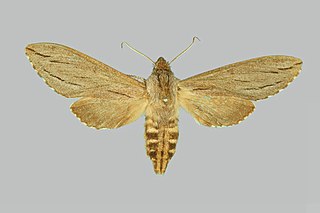 W
WSphinx sequoiae, the sequoia sphinx, is a moth of the family Sphingidae. It is found in the United States from Oregon south through California, Nevada, and south-eastern Utah to Arizona and further south into Mexico's northern Baja California.
 W
WThe desert sucker or Gila Mountain sucker, is a freshwater species of ray-finned fish in the sucker family, endemic to the Great Basin and the Colorado River Basin in the United States. It inhabits rapids and fast-flowing streams with gravelly bottoms. It is a bi-colored fish with the upper parts olive brown to dark green, and the underparts silvery-tan or yellowish. The head is cylindrical, tapering to a thick-lipped mouth on the underside. This fish can grow to 31 in (79 cm) in Arizona but is generally only about half this size elsewhere. There are three subspecies, found in different river basins, and some authorities allot this species its own genus Pantosteus.
 W
WThe Modoc sucker is a rare species of freshwater fish native to northern California and southern Oregon. It grows to a length of about 7 in (18 cm) and becomes sexually mature at 4 in (10 cm). It feeds on algae, small invertebrates and detritus, and hides under stones, detritus and overhanging vegetation. It is found in only a few streams and is listed as an endangered species in California and the United States. Conservation measures have been put in place such as fencing the streams in which it lives from livestock. It was previously rated as "endangered" by the International Union for Conservation of Nature, but this rating has now been changed to "near threatened".
 W
WThe Owens sucker is a fish in the family Catostomidae which is endemic to California.
 W
WThe Tahoe sucker is a freshwater Cypriniform fish inhabiting the Great Basin region of the Western United States.
 W
WThe Warner sucker is a rare species of freshwater ray-finned fish in the family Catostomidae. Native to Oregon in the United States and found only in the Warner Basin, its distribution extends just into Nevada and California. It is a federally listed threatened species. Its other common name is redhorse. The International Union for Conservation of Nature has rated this fish as an endangered species because of its small extent of occurrence, the small number of locations in which it is found, and the extreme fluctuations in area of occupancy resulting from drought and water abstraction. Conservation efforts have been put in place.
 W
WThe black toad, also known as the Inyo toad or Deep Springs toad, is a true toad that lives only in scattered oases in the Deep Springs Valley of Inyo County, California. In fact, its original scientific name, Bufo exsul, means "exiled toad," which refers to its species' isolation in a tiny spot in the high desert wilderness of the Californian Great Basin.
 W
WThe White River springfish is a species of fish in the family Goodeidae, the splitfins. It is a rare species of the Great Basin of western United States, where it is endemic to isolated warm springs in the White River drainage of eastern Nevada.
 W
WThe Bonneville whitefish is a salmonid fish endemic to Bear Lake on the Utah-Idaho border. It is one of three species of Prosopium endemic to Bear Lake, the other two being the Bear Lake whitefish and the Bonneville cisco. The species is listed as a Wildlife Species of Concern by the Utah Division of Wildlife Resources.
 W
WThe mountain whitefish is one of the most widely distributed salmonid fish of western North America. It is found from the Mackenzie River drainage in Northwest Territories, Canada south through western Canada and the northwestern USA in the Pacific, Hudson Bay and upper Missouri River basins to the Truckee River drainage in Nevada and Sevier River drainage in Utah.
 W
WThe Yuma myotis is a species of vesper bat native to western North America.